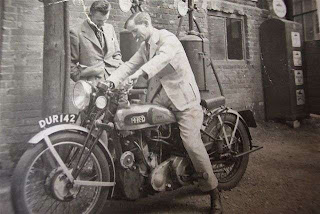



The Vincent HRD Series A Rapide is introduced.
The story is that supposedly Phil Irving accidentally put a side-view tracing of the Vincent 500 motor wrong way up on top of an equally sized drawing of the same view of the same motor, and saw, moving the tracing so the crankshafts and idler gears coincided, that the result looked like a possible design for a V-twin. This resulted in the 47.5 degree V-twin.
The new Vincent V-twin incorporated a number of new and innovative ideas, some of which were more successful than others.
The Series A Rapide's frame was of brazed lug construction, based on the Comet design but extended to accommodate the longer V twin engine. It continued the use of "cantilever" rear suspension, which was used on all Vincents produced from 1928 through 1955. Other improvements/innovations included a Burman 4-speed gearbox, 6.8:1 compression, 1.0625 inch Amal carb and a side stand.
Both Phil Vincent and Phil Irving refused to use pneumatic forks believing girders were superior at the time. The Series-A had external oil lines and a separate gearbox. The 998cc Series A Rapide Vincent cost $600, produced 45 hp, and was capable of 110 miles per hour.
The high power meant that the gearbox and clutch did not cope well and led to many a breakdown. Too many in fact, leading to the Series B Rapide's radical changes in 1946. (50 degree V-twin instead of 47.5, internal oil lines, unit construction, etc.)
An interesting Vincent fact for you; in 1948, Indian Motorcycles distributed Vincents in the States along with other British motorcycles including AJS, Royal Enfield, Matchless and Norton Motorcycle Company. That same year an Indian Chief was sent to Stevenage to be fitted with a Vincent Series B Rapide engine. Unfortunately, the resulting hybrid "Vindian" never went into production. Can you imagine it?! The mind runs wild.

